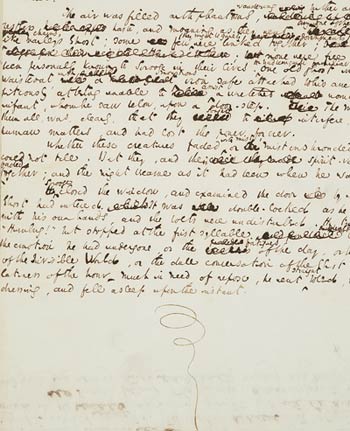 Dickens wrote the manuscript of A Christmas Carol in black ink, using his customary goose quill pen, on a mixture of high-quality, unlined paper: "London Superfine" for the title page and preface, and "Bath Superfine" for the narrative. Each sheet measured 8 7/8 x 7 1/4 inches. As soon as he completed the story on 2 December, he folded the manuscript vertically and either took or sent it to the printer, Bradbury and Evans. The compositors had to set type extremely quickly in order for the book to be completed by 19 December, just in time for the Christmas market. The printer sent proofs for Dickens to review by 4 or 5 December, but none of the author's revised proof pages survive.
Dickens wrote the manuscript of A Christmas Carol in black ink, using his customary goose quill pen, on a mixture of high-quality, unlined paper: "London Superfine" for the title page and preface, and "Bath Superfine" for the narrative. Each sheet measured 8 7/8 x 7 1/4 inches. As soon as he completed the story on 2 December, he folded the manuscript vertically and either took or sent it to the printer, Bradbury and Evans. The compositors had to set type extremely quickly in order for the book to be completed by 19 December, just in time for the Christmas market. The printer sent proofs for Dickens to review by 4 or 5 December, but none of the author's revised proof pages survive.
The hundreds of revisions within the manuscript vividly convey the sense of an author writing at a fast pace, usually enacting his second thoughts and changes of mind in the heat of original composition, striking out words and phrases and replacing them with a seemingly unhesitating, continuous flow of new words on the same line. He deleted text with a cursive and continuous looping movement of the pen—rendering his first thoughts exasperatingly difficult to decipher. At the end of each "stave," he inserted a spiral swirl (known as a flourish)—a cue to the printer that the chapter had ended.
Plan your visit. 225 Madison Avenue at 36th Street, New York, NY 10016.
Plan your visit. 225 Madison Avenue at 36th Street, New York, NY 10016.
